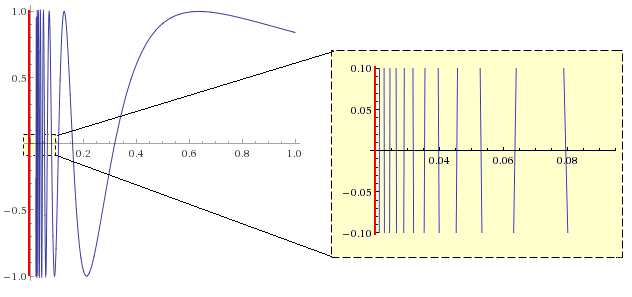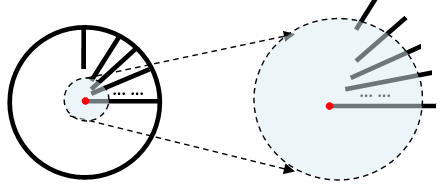Locally Connected Spaces
Recall that each topological space X is the set-theoretic disjoint union of its connected components, but in general (e.g. for X=Q) fails to be the topological disjoint union. The problem is that the connected components in general aren’t open in X. We’ll seek to right this wrong here, by looking at a specific class of topological spaces.
Definition. A topological space X is said to be locally connected if
- for each open subset
and
there exists a connected open subset V of X such that
Note that since U is open in X, any subset is open in U if and only if it’s open in X. In such instances, we’ll sometimes abuse our language and say “V is open” without specifying the ambient space.
One useful way to judge if a space is locally connected is as follows.
Proposition 1. A topological space X is locally connected if and only if it has a basis all of whose elements are connected.
Proof.
(→) Let be open; we need to show it’s a union of connected open subsets of X. Indeed, for
by local connectedness, there’s a connected open subset
containing x. So U is indeed a union of connected open subsets.
(←) Let be open and
Now we can write U as a union of connected open subsets. One of these (say V) must contain x. ♦
The key property we wish to prove is:
Theorem 2. If X is locally connected, then every connected component of X is open in X. Hence X is the topological disjoint union of its connected components.
Proof.
Let , where Y is a connected component of X. By definition, x is contained in some open connected subset U of X. Since Y is a maximal connected set containing x, we have
This shows that Y is open in X. ♦
Important Non-Example
Take our favourite topologist’s sine curve where:
and
We saw that X is connected. However it is not locally-connected since for any , the ε-neighbourhood of the origin contains more than one (in fact infinitely many!) connected components:
This also shows that connected spaces are generally not locally connected.
Corollary. A locally connected space X is totally disconnected if and only if it’s discrete.
Proof.
If X is totally disconnected, each {x} is a connected component; since X is locally connected, each connected component is open in X. ♦
Properties of Locally Connected Spaces
Similar to the case of locally compact, the following result explains why the property is “local”.
Proposition 3. Let X be a topological space.
- If
is open, and X is locally connected, then so is U.
- If
is a union of open subsets and each Ui is locally connected, then so is X.
Proof.
1st statement: let where U’ is open in U. Then U’ is open in X so there exists a connected open subset V of X such that
This V is also open in U.
2nd statement: let be open and
. Then
for some i. By local connectedness of Ui, and
there exists a connected open subset V of Ui ∩ U such that
Thus,
♦
It’s not true that if f : X → Y is continuous and X is locally connected, then so is f(X). Indeed, let X = Q with the discrete topology and Y = Q as a subspace of R. The identity map on the underlying set Q then gives a surjective continuous map but Y is not locally connected. [ Recall that if we replace “locally connected” with “connected”, then this is true. ]
Closed subsets of locally connected spaces are not locally connected in general. E.g. take X = R and Then Y is closed in X, but there’s no connected open subset of 0 in Y.
–
Proposition 4. If X and Y are locally connected topological spaces, then so is X × Y.
Proof.
Since X is locally connected, there is a basis BX comprising of open connected subsets. Likewise, pick such a basis BY for Y. Then is a basis of X × Y comprising of open connected subsets. ♦
This does not hold for infinite products. For example, let X = {0, 1}N, where {0, 1} is given the discrete topology. We claim that X is totally disconnected.
Indeed, suppose some connected component Y contains where
for some n. Then projecting to the n-th component gives a surjective map
which violates the theorem that the continuous image of a connected set is connected.
Hence, X is a totally disconnected space which is not discrete (since it’s compact by Tychonoff theorem), so it can’t be locally connected (see corollary to theorem 2).
Examples
- Any discrete set is locally connected since we can take V={x}.
- Since the open intervals in R are connected, R has a basis of connected open subsets and is thus locally connected.
- Hence Rn is also locally connected by proposition 4, as is any open subset of Rn by proposition 3.
- Let X = [0, 1]; then X is connected and locally connected. For example, at 0, any open subset must contain
for some ε>0, which is open in X.
- Q is totally disconnected yet not discrete, so it’s not locally connected.
Locally Path-Connected Spaces
Correspondingly, we have locally path-connected spaces.
Definition. A topological space X is locally path-connected if
- for each open subset
and
there exists a path-connected open subset V of X such that
The earlier properties all carry over since the proofs can be replicated by replacing “path-connected” with “connected” whenever it appears in the text.
Proposition 5. A topological space X is locally path-connected if and only if it has a basis all of whose elements are connected.
Theorem 6. If X is locally path-connected, then every path-connected component of X is open in X. Hence X is the topological disjoint union of its path-connected components.
Proposition 7. Let X be a topological space.
- If
is open, and X is locally path-connected, then so is U.
- If
is a union of open subsets and each Ui is locally path-connected, then so is X.
Proposition 8. If X and Y are locally path-connected, then so is X × Y.
Examples (same as earlier).
- Any discrete set is locally path-connected since we can take V={x}.
- Since the open intervals in R are path-connected, R has a basis of path-connected open subsets and is thus locally path-connected.
- Hence Rn is also locally path-connected, as is any open subset of Rn.
- Let X = [0, 1]; then X is path-connected and locally path-connected. For example, at 0, any open subset must contain
for some ε>0, which is open in X.
- Q is totally disconnected; since each connected component is a disjoint union of path components, we see that the only path components of Q are {x}. Hence, Q is not locally path-connected, for if it were, Q would have to be the disjoint union of all {x} and hence discrete.
Let’s see if we can find counter-examples similar to those for local connectedness.
Non-Properties
1. Not true: if X is path-connected, then it’s locally path-connected.
Take the circle and consider an infinite sequence of wheel spokes:
and:
for n = 1, 2, … .
Now take :
Now there’s no path-connected open subset V such that On the other hand, X is clearly path-connected.
2. Not true: if f : X → Y is continuous and X is locally path-connected, then so is Y.
Same example as before: let X=Q with the discrete topology and Y=Q as a subspace of R. Then the identity map on Q is continuous and X is locally path-connected, but f(X) = Y is not.
3. Not true: a product of infinitely many locally path-connected spaces is locally path-connected.
Same example as before: X = {0, 1}N, where {0, 1} is given the discrete topology. We saw earlier that X is totally disconnected, so the components (and hence path components) are singleton sets. On the other hand, X is not discrete, so it cannot be locally path-connected.
Relationship Between (Locally) Connected & Path-connected
Finally, let’s examine the relationship between the two notions. Since path-connected sets are connected, we have:
1. A locally path-connected space is also locally connected.
The converse isn’t true.
2. A locally connected space is not locally path-connected in general.
This is hard: one can find a counter-example in Munkres, “Topology“, 2nd edition, page 162, chapter 25, exercise 3.
3. If X is connected and locally path-connected, then it’s path-connected.
Pick any path component Y of X. Since X is locally path-connected, Y is open in X. The complement X–Y is a union of path components, each open in X, so it’s open too. Thus Y is a clopen subset of X and we must have Y=X.
Summary
The following summarises various properties of compactness, connectedness and path-connectedness. Note: for any property that mentions local compactness, we also assume X is Hausdorff.
| C | Compact | Connected | Path-connected |
| If X is C, and f:X→Y is continuous, then f(X) is C. | 🙂 | 🙂 | 🙂 |
| If each Xi is C, then their product also is C. | 🙂 | 🙂 | 🙂 |
| C implies (locally C). | 🙂 | – | – |
| If X is locally C, then so is any open subset U of X. | 🙂 | 🙂 | 🙂 |
| If X is locally C, then so is any closed subset of X. | 🙂 | – | – |
| If |
🙂 | 🙂 | 🙂 |
| If f:X→Y is continuous and X is locally C, then so is f(X). | – | – | – |
| If X and Y are locally C, then so is X × Y. | 🙂 | 🙂 | 🙂 |
| If each Xi is locally C for infinitely many i, then so is their product. | – | – | – |






What do you mean by “Recall that each topological space X is the set-theoretic disjoint union of its connected components, but in general (e.g. for X=Q) fails to be the topological disjoint union. “?
Isn’t Q also disjoint union of connected components?
Sorry for the late reply. Q is set-theoretically the disjoint union of its connected components, but not the topological disjoint union, simply because a singleton point is not an open subset of Q.
You state that $Y$ and $Z$ are connected components of topologist’s sine curve, a connected space. However, any connected space should have itself as the only connected component.
You’re right! Corrected it.